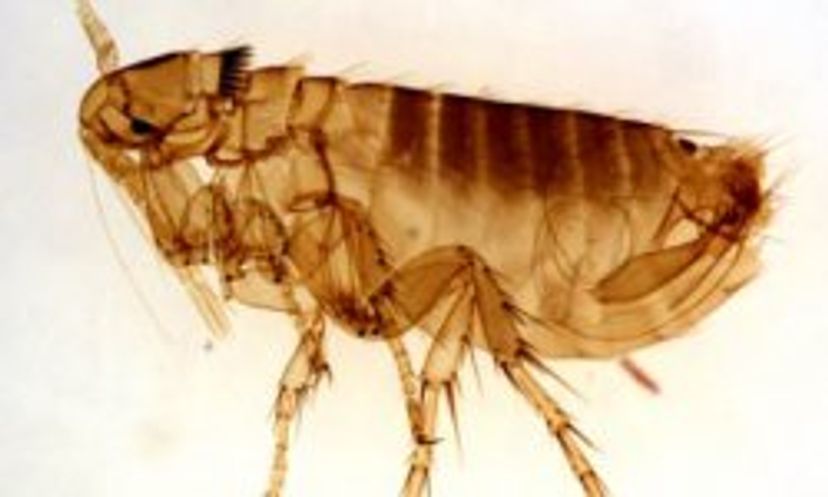
About This Quiz
With millions of pets in the world, there seems to be no shortage of fleas. Fleas can carry serious diseases that can infect humans and they have no regard for the health of their unwilling hosts. Do you know enough about fleas to get rid of them when you have an infestation? Take our quiz to learn more about the flea.Although newly emerged fleas need to find food within a few days, adults can go for a couple of months without a meal. Leaving a flea-infested home for a couple of weeks will not solve the problem, because your little friends simply await your timely return.
Flea pupae can stay in their cocoons for up to a year, waiting to sense body heat and vibrations that signal the presence of nearby hosts. In no time flat, they break out of their cocoons and hop on board the first warm-blooded human or animal to pass by.
Fleas, lice, and ticks are all ectoparasites, or parasites that live outside a host’s body. Tapeworms are an example of an endoparasite, which are parasites that live inside a host’s body.
Advertisement
Mistletoe is a parasitic plant, but since it has leaves and can produce food through photosynthesis, it is not a true parasite. Mistletoes use a host mainly for water and mineral nutrients and have been known to eventually kill their hosts.
Parasites do not help their hosts in any way so the relationship is not symbiotic. Many parasites carry life-threatening diseases that infect their hosts or pass on other parasites with their bites that go on to live within a host.
Fleas bodies are covered with hard plates called sclerites, so if you do catch one, squashing it can be very difficult. Their hard outer shell protects fleas from everything including an animal's teeth and hitting the floor after a long jump.
Advertisement
A flea’s flattened body that is covered with backward-pointing hairs make it easy for fleas to crawl through their host's fur. However, if something tries to dislodge them, the hairs act like tiny Velcro anchors that hold them in place.
The flea’s back legs are very long, and the flea can bend them at several joints, which allows it to make amazing jumps. As it lands, a flea uses tiny claws on the ends of its legs to grasp the surface under it.
A flea can jump about 7 inches (17.8 centimeters) vertically or 13 inches (33 centimeters) horizontally. In human proportions, that's a 250-foot (76-meter) vertical jump or a 450-foot (137-meter) horizontal jump.
Advertisement
Flea eggs hatch into worm-like larvae that spin cocoons and become pupae, an adult flea emerges from the cocoon. In a population of fleas, about 50 percent are eggs and only about 5 percent are adults, with the remainder is some stage of pupae development.
A female flea can lay about 20 eggs at a time and around 500 eggs during her lifetime. If a female emerges from her cocoon and is not able to find food, she will die without reproducing.
Flea eggs are smooth so that they fall off the host as it moves around. In a home the eggs sink deep into a carpets fiber or in floor cracks and outside they settle into the soil.
Advertisement
The black flecks you see on an infested animal are particles of dried blood and flea droppings. Flea eggs are white in color and you will not likely be able to see them.
In order to develop, flea eggs need a warm, moist environment: a temperature of about 70 degrees Fahrenheit (21 degrees Celsius) and 70 to 85 percent humidity. In these conditions, the eggs will hatch in about 12 days.
Flea larvae do not eat blood but instead they eat skin cells, flea droppings and other debris. Larvae develop through three stages, molting after each before they spin silk cocoons after a week or two.
Advertisement
Flea larvae feed on the eggs of tapeworms. Once swallowed, the tapeworm begins to develop in the gut of a flea and if an animal swallows an infected flea while grooming, the animal becomes infected with tapeworm.
Fleas are vectors for bubonic plague, they transport plague bacteria from rodents, the natural carriers of the disease, to people. A particular species of flea, the oriental rat flea, is usually the culprit that acts as a vector.
A murine typhus he infection results from an infected flea's waste rather than the flea's mouth. The fleas defecate while they are eating, and their host often scratches the infected waste into a bite.
Advertisement
Always treat your animals and their environment at the same time. Vacuum your home at least every other day, then immediately empty the canister or replace the bag and dispose of it in a tightly tied plastic bag outside your home.
Feeding brewer's yeast, garlic and vitamin supplements to pets is unlikely to do much good against fleas. Flea collars have limited effectiveness against a flea infestation and ultrasonic collars do not appear to act as an effective flea deterrent or repellent.